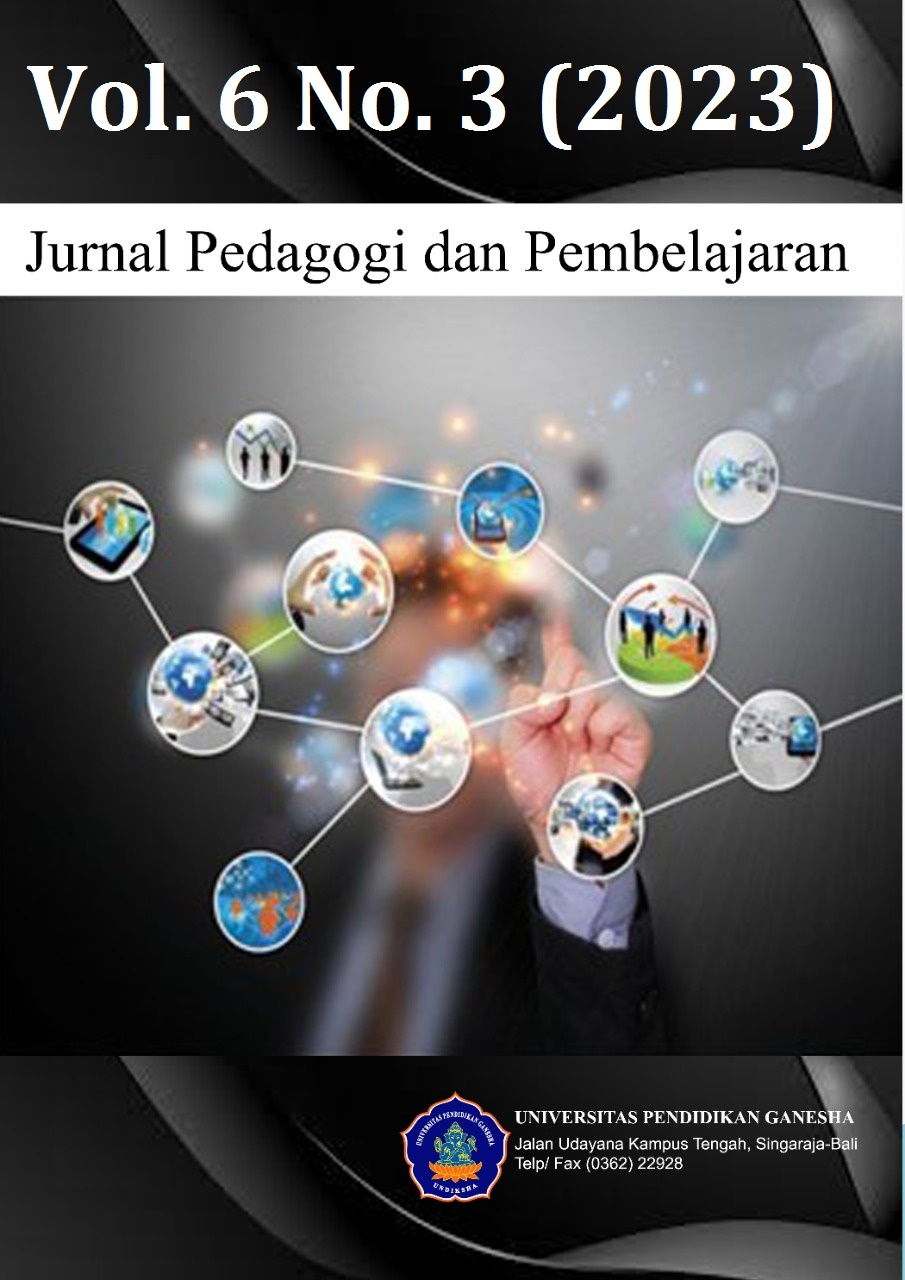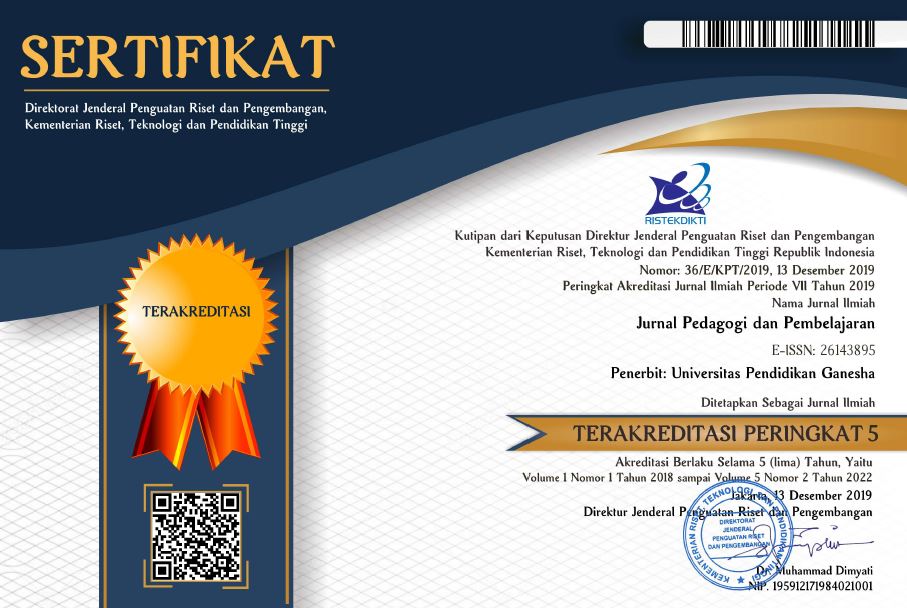Students' Analogical Reasoning in Solving Geometry Problems Viewed from Visualizer's and Verbalizer's Cognitive Style
DOI:
https://doi.org/10.23887/jp2.v6i3.60960Keywords:
Analogical Reasoning, Geometric Problems, Cognitive Style, Verbalizer, VisualizerAbstract
Many studies state that students' geometric problem-solving abilities in Indonesia are low. This research examines students' analogical reasoning in solving geometric problems in terms of their cognitive style. This descriptive qualitative research involves 32 class X high school students. The data collection methods used were tests, questionnaires, and interviews. The data analysis technique uses qualitative descriptive analysis. The results showed that the analogical reasoning of students with a visualizer cognitive style was superior to the analogical sense of students with a verbalizer cognitive style in solving geometric problems. Students with a visualizer cognitive style can achieve four components of analogical reasoning: encoding, inferring, mapping, and applying. Students with a verbalizer cognitive style only achieve two parts: encoding and inferring. The implication of this research is the need for educators to identify each student's learning style, which can be done through initial learning assessments and providing differentiated learning stimuli to students according to their cognitive style. Strengthening students with a verbalizer cognitive style needs to be emphasized more during the mapping and applying process, including providing appropriate scaffolding and allowing students to verbally express problem-solving strategies, teaching material by showing problem concept maps, and increasing practice on more varied questions.
References
Ayyubi, I. I. A., Nudin, E., & Bernard, M. (2018). Pengaruh Pembelajaran Berbasis Masalah Terhadap Kemampuan Pemecahan Masalah Matematis Siswa SMA. JPMI (Jurnal Pembelajaran Matematika Inovatif), 1(3), 355–360. https://doi.org/10.22460/jpmi.v1i3.p355-360.
Azizah, U. Q., Rooselyna, E., & Masriyah, M. (2021). Students’ Analogical Reasoning in Solving Trigonometric Problems in Terms of Cognitive Style: A Case Study. International Journal for Educational and Vocational Studies, 3(1), 71-79. https://doi.org/10.29103/ijevs.v3i1.3398.
Brookman-Byrne, A., Mareschal, D., Tolmie, A. K., & Dumontheil, I. (2019). The Unique Contributions of Verbal Analogical Reasoning and Nonverbal Matrix Reasoning to Science and Maths Problem- Solving in Adolescence. Mind, Brain, and Education, 13(3), 211–223. https://doi.org/10.1111/mbe.12212.
Buckley, J., Seery, N., & Canty, D. (2019). Investigating the use of spatial reasoning strategies in geometric problem solving. International Journal of Technology and Design Education, 29(2), 341–362. https://doi.org/10.1007/s10798-018-9446-3.
Chasanah, C., Riyadi, & Usodo, B. (2020). The Effectiveness of Learning Models on Written Mathematical Communication Skills Viewed from Students’ Cognitive Styles. European Journal of Educational Research, 9(3), 979–994. https://doi.org/10.12973/eu-jer.9.3.979.
Dumas, D., Dong, Y., & Doherty, M. (2021). The Influence of Creative Expertise on the Sensitivity and Selectivity of Analogical Reasoning. Mind, Brain, and Education, 15(3), 239–249. https://doi.org/10.1111/mbe.12287.
Fatmalasari, D. A. F., & Siswono, T. Y. E. (2020). Refractive Thinking of Visualizer and Verbalizer Students in Solving Geometry Problems. MATHEdunesa, 9(2), 356–362. https://doi.org/10.26740/mathedunesa.v9n2.p356-362.
Fitria, R. (2018). Analisis Kemampuan Pemecahan Masalah Matematis Siswa pada Materi Aritmatika Sosial Kelas VII SMP dalam Pembelajaran Matematika. Jurnal Pendidikan Tambusai, 2(2), 786–792. https://doi.org/10.31004/jptam.v2i4.42.
Friston, K. J., Wiese, W., & Hobson, J. A. (2020). Sentience and the Origins of Consciousness: From Cartesian Duality to Markovian Monism. Entropy, 22(5), 1-31. https://doi.org/10.3390/e22050516.
Gabriel, F., Buckley, S., & Barthakur, A. (2020). The impact of mathematics anxiety on self-regulated learning and mathematical literacy. Australian Journal of Education, 64(3), 227–242. https://doi.org/10.1177/0004944120947881.
Gusau, M. B., Mohamad, M. M., Yusof, Y., & Ahmad, A. (2019). Investigating Students` Cognitive Style and Problem Solving Skills in Conducting Undergraduate Final Year Project. Online Journal for TVET Practitioners, 4(1), 1-8. https://publisher.uthm.edu.my/ojs/index.php/oj-tp/article/view/4946
Hasan, B. (2019). The Analysis of Students’ Critical Thinking Ability with Visualizer-Verbalizer Cognitive style in Mathematics. International Journal of Trends in Mathematics Education Research, 2(3), 142-
https://doi.org/10.33122/ijtmer.v2i3.97.
Herawati, L., & Akbar, R. E. (2019). Conjecturing Via Analogical Reasoning to Trigger Divergent and Convergent Thinking. International Journal of Innovation, 9(1), 258-277. https://www.ijicc.net/images/vol9iss1/9123_Supratman_2019_E_R.pdf.
Hwang, W.-Y., & Hu, S.-S. (2013). Analysis of peer learning behaviors using multiple representations in virtual reality and their impacts on geometry problem solving. Computers & Education, 62, 308– 319. https://doi.org/10.1016/j.compedu.2012.10.005.
Isoda, M., & Katagiri, S. (2012). Mathematical Thinking: How to Develop it in the Classroom. Singapore: World Scientific.
Kristayulita. (2021). Indirect Analogical Reasoning Components. Malikussaleh Journal of Mathematics Learning, 4(1), 13–19. https://doi.org/10.29103/mjml.v4i1.2939.
Kristayulita, K., Nusantara, T., As’ari, A. R., & Sa’dijah, C. (2020). Schema of Analogical Reasoning-Thinking Process in Example Analogies Problem. Eurasian Journal of Educational Research, 88, 87–104. https://dergipark.org.tr/en/pub/ejer/issue/57483/815309.
Kurniawan, H., Darmono, P. B., Mursalin, M., Shang, Y., Weinhandl, R., & Sharm, R. (2022). Describe mathematical creative thinking skills and problem-solving strategies by prospective teacher students on non-routine problems. International Journal of Trends in Mathematics Education Research, 5(2), 119-124. https://doi.org/10.33122/ijtmer.v5i2.140.
Kusmaryono, I., Suyitno, H., Dwijanto, D., & Dwidayati, N. (2019). The Effect of Mathematical Disposition on Mathematical Power Formation: Review of Dispositional Mental Functions. International Journal of Instruction, 12(1), 343–356. https://doi.org/10.29333/iji.2019.12123a.
Lailiyah, S., Kusaeri, K., Retnowati, E., & Erman, E. (2022). A Ruppert’s Framework: How Do Prospective Teachers Develop Analogical Reasoning in Solving Algebraic Problems? Journal of Research and Advances in Mathematics Education, 7(3)145–160. https://doi.org/10.23917/jramathedu.v7i3.17527.
Masikhah, A., Mahmudah, W., & Wildani, J. (2021). Penerapan Pembelajaran Van Hiele untuk Mendukung Pemecahan Masalah Geometri. UJMC (Unisda Journal of Mathematics and Computer Science), 7(1), 1-10. https://doi.org/10.52166/ujmc.v7i1.2447.
McCunn, L., & Cilli-Turner, E. (2020). Spatial Training and Calculus Ability: Investigating Impacts on Student Performance and Cognitive Style. Journal of Educational Research and Practice, 10(1), 317–337. https://doi.org/10.5590/JERAP.2020.10.1.20.
McEwan, R. C., & Reynolds, S. (2007). Verbalisers and Visualisers: Cognitive Styles That Are Less Than Equal.
London: Fanshawe College, Disability Services, Counselling & Student Life.
Minda, J. P. (2020). The Psychology of Thinking: Reasoning, Decision-Making and Problem-Solving. California: SAGE Publications Ltd.
Muslimin, M., & Sunardi, S. (2019). Analisis Kemampuan Penalaran Matematika Siswa SMA Pada Materi Geometri Ruang. Kreano, Jurnal Matematika Kreatif-Inovatif, 10(2), 171-178 https://doi.org/10.15294/kreano.v10i2.18323.
Ni’mah, Z., Lukito, A., & Rahadjeng, B. (2022). Penalaran analogis siswa dalam menyelesaikan masalah geometri ditinjau dari perbedaan gender. Jurnal Kajian Pembelajaran Matematika, 6(2), 116-124. https://doi.org/10.17977/um076v6i22022p116-124.
Nisa, A., & Dwiningsih, K. (2022). Analisis Hasil Belajar Peserta Didik Melalui Media Visualisasi Geometri Molekul Berbasis Mobile Virtual Reality (MVR). PENDIPA Journal of Science Education, 6(1), 135-142. https://doi.org/10.33369/pendipa.6.1.135-142.
Novitasari, N. T., & Shodikin, A. (2020). Pengaruh Penerapan Model Pembelajaran Logan Avenue Problem Solving (LAPS-Heuristik) terhadap Kemampuan Pemecahan Masalah pada Soal Cerita Barisan dan Deret Aritmetika. Jurnal Tadris Matematika, 3(2), 153–162. https://doi.org/10.21274/jtm.2020.3.2.153-162.
Öztürk, M., Akkan, Y., & Kaplan, A. (2020). Reading comprehension, Mathematics self-efficacy perception, and Mathematics attitude as correlates of students’ non-routine Mathematics problem-solving skills in Turkey. International Journal of Mathematical Education in Science and Technology, 51(7), 1042–1058. https://doi.org/10.1080/0020739X.2019.1648893.
Pan, D., Yang, L., She, M., Ding, X., & Li, Z. (2020). Effects of Cognitive Style and Information Acquisition Method on Diagnosis Task Performance. International Journal of Human–Computer Interaction, 36(13), 1231–1241. https://doi.org/10.1080/10447318.2020.1728613.
Rahman, M. M. (2019). 21st Century Skill “Problem Solving”: Defining the Concept. Asian Journal of Interdisciplinary Research, 2(1), 64-74. https://doi.org/10.34256/ajir1917.
Ramdhani, M. F., H.b, U., & Anggraini. (2019). Analisis Kategori Penalaran Analogi Siswa dalam Memecakan Masalah Geometri ditinjau dari Gaya Kognitif. Jurnal Elektronik Pendidikan Matematika Tadulako, 6(3), 327-342. http://jurnal.untad.ac.id/jurnal/index.php/JEPMT/article/view/12529/9715.
Sapitri, Y., Utami, C., & Mariyam, M. (2019). Analisis Kemampuan Pemecahan Masalah Matematis Siswa dalam Menyelesaikan Soal Open-Ended pada Materi Lingkaran Ditinjau dari Minat Belajar. Variabel, 2(1), 16–23. https://doi.org/10.26737/var.v2i1.1028.
Schleicher, A. (2019). PISA 2018 Insights and Interpretations. OECD Publishing. https://doi.org/10.1787/b25efab8-en.
Setiawan, A., & Sa’dijah, C. (2020). Analysis of Students Errors in Mathematical Reasoning on Geometry by Gender. Journal of Disruptive Learning Innovation (JODLI), 1(2), 59-66. https://doi.org/10.17977/um072v1i22020p59-66.
Shodikin, A., Purwanto, P., Subanji, S., & Sudirman, S. (2021). Students’ Thinking Process When Using Abductive Reasoning in Problem Solving. Acta Scientiae, 23(2), 58-87. https://doi.org/10.17648/acta.scientiae.6026.
Son, A. L., Darhim, & Fatimah, S. (2020). Students’ Mathematical Problem-Solving Ability Based on Teaching Models Intervention and Cognitive Style. Journal on Mathematics Education, 11(2), 209–222. http://doi.org/10.22342/jme.11.2.10744.209-222.
Sternberg, R. J. (2019). Human Intelligence: An Introduction. Cambridge: Cambridge University Press. Sulistyorini, Y. (2018). Error Analysis in Solving Geometry Problem on Pseudo-Thinking’s Students. 103–107.
https://doi.org/10.2991/incomed-17.2018.22.
Surur, M., Degeng, I. N. S., Setyosari, P., & Kuswandi, D. (2020). The Effect of Problem-Based Learning Strategies and Cognitive Styles on Junior High School Students’ Problem-Solving Abilities. International Journal of Instruction, 13(4), 35–48. https://doi.org/10.29333/iji.2020.1343a.
Sutama, Anif, S., Prayitno, H. J., Narimo, S., Fuadi, D., Sari, D. P., & Adnan, M. (2021). Metacognition of Junior High School Students in Mathematics Problem Solving Based on Cognitive Style. Asian Journal of University Education, 17(1), 134–144. https://doi.org/10.24191/ajue.v17i1.12604.
Tambunan, H. (2019). The Effectiveness of the Problem Solving Strategy and the Scientific Approach to Students’ Mathematical Capabilities in High Order Thinking Skills. International Electronic Journal of Mathematics Education, 14(2), 293–302. https://doi.org/10.29333/iejme/5715.
Tanudjaya, C. P., & Doorman, M. (2020). Examining Higher Order Thinking in Indonesian Lower Secondary Mathematics Classrooms. Journal on Mathematics Education, 11(2), 277–300. https://doi.org/10.22342/jme.11.2.11000.277-300.
Toomey, N., & Heo, M. (2019). Cognitive Ability and Cognitive Style: Finding a Connection through Resource Use Behavior. Instructional Science: An International Journal of the Learning Sciences, 47(4), 481– 498. https://doi.org/10.1007/s11251-019-09491-4.
Vogelaar, B., & Resing, W. C. M. (2018). Changes over Time and Transfer of Analogy-Problem Solving of Gifted and Non-Gifted Children in a Dynamic Testing Setting. Educational Psychology, 38(7), 898– 914. https://doi.org/10.1080/01443410.2017.1409886.
Vogelaar, B., Sweijen, S. W., & Resing, W. C. M. (2019). Gifted and Average-Ability Children’s Potential for Solving Analogy Items. Journal of
Intelligence, 7(3), 1–15. https://doi.org/10.3390/jintelligence7030019.
Vogelaar, B., Veerbeek, J., Splinter, S. E., & Resing, W. C. M. (2021). Computerized Dynamic Testing of Children’s Potential for Reasoning by Analogy: The Role of Executive Functioning. Journal of Computer Assisted Learning, 37(3), 632–644. https://doi.org/10.1111/jcal.12512Wang,
L., Zeng, J., Ran, X., Cui, Z., & Zhou, X. (2022). Different Cognitive Mechanisms for Process-Open and Process-Constrained Problem Solving. ZDM: Mathematics Education, 54(3), 529–541. https://doi.org/10.1007/s11858-022-01373-3.
Wang, Z., & Han, F. (2017). Metacognitive knowledge and metacognitive control of writing strategy between high-and low-performing Chinese EFL writers. Theory and Practice in Language Studies, 7(7), 523– 532. http://dx.doi.org/10.17507/tpls.0707.04.
Downloads
Published
How to Cite
Issue
Section
License
Copyright (c) 2023 Ali Shodikin, Tatik Retno Murniasih, Siti Faizah, Dea Wulan Ekawati

This work is licensed under a Creative Commons Attribution-ShareAlike 4.0 International License.
Authors who publish with Jurnal Pedagogi dan Pembelajaran agree to the following terms:- Authors retain copyright and grant the journal the right of first publication with the work simultaneously licensed under a Creative Commons Attribution License (CC BY-SA 4.0) that allows others to share the work with an acknowledgment of the work's authorship and initial publication in this journal
- Authors are able to enter into separate, additional contractual arrangements for the non-exclusive distribution of the journal's published version of the work (e.g., post it to an institutional repository or publish it in a book), with an acknowledgment of its initial publication in this journal.
- Authors are permitted and encouraged to post their work online (e.g., in institutional repositories or on their website) prior to and during the submission process, as it can lead to productive exchanges, as well as earlier and greater citation of published work. (See The Effect of Open Access)













